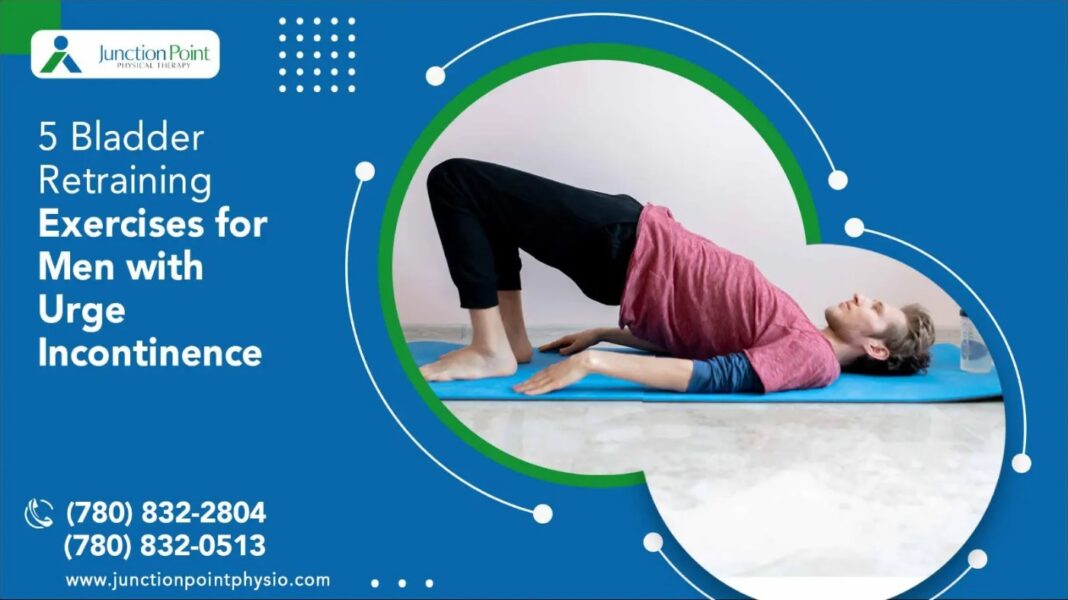Urge incontinence is a common condition affecting men. An overactive bladder, neurological issues, or complications from prostate surgery often cause it. The condition results in a sudden and intense urge to urinate, sometimes leading to leakage before reaching a restroom. Here is where male pelvic floor physiotherapy comes in. Practical bladder retraining exercises and pelvic floor physiotherapy in Grande Prairie can strengthen pelvic floor muscles, enhance bladder control, and improve overall quality of life.
Common Causes of Urge Incontinence
- Neurological Conditions: Disorders like Parkinson’s, multiple sclerosis, or spinal cord injuries disrupt nerve signals between the brain and bladder, triggering involuntary contractions.
- Bladder Irritants: Excessive consumption of caffeine, alcohol, or acidic foods can irritate the bladder lining, exacerbating symptoms.
- Post-Surgical Effects: Procedures such as prostate surgery or pelvic surgery may weaken bladder control, contributing to urge incontinence.
- Infections and Inflammation: Urinary tract infections (UTIs) or chronic bladder inflammation can cause frequent urges and leakage.
- Age-Related Changes: Aging leads to reduced bladder capacity and weaker pelvic floor muscles, increasing the likelihood of incontinence.
Five Essential Exercises for Men Tackling Urge Incontinence
Below are five highly targeted exercises tailored for men with urge incontinence, followed by actionable insights to support long-term management.
1. Pelvic Floor Muscle Contractions (Kegels)
The pelvic floor muscles play a pivotal role in managing bladder control and reducing leakage, especially for men with urge incontinence. Strengthening these muscles can help men regain voluntary control over their bladder, reducing the sudden urges associated with the condition through pelvic floor physiotherapy in Grande Prairie.
How to Perform:
To begin, men with urge incontinence should identify their pelvic floor muscles by attempting to stop the flow of urine midstream. Once identified, practice in a seated or reclined position. Contract these muscles tightly, hold the contraction for about 5 seconds, and then relax for about 5 seconds. As strength improves, increase the hold duration to 10 seconds. Aim for 10 repetitions, performed three times daily. Men should avoid tensing the abdomen, thighs, or buttocks during the exercise to ensure proper targeting of the pelvic floor muscles through pelvic health physiotherapy. Consistent practice is key to managing symptoms of urge incontinence effectively.
2. Timed Voiding and Bladder Training
Frequent urination is a hallmark of urge incontinence in men. Timed voiding exercises can help retrain the bladder to hold urine for long intervals, reducing the frequency of sudden urges.
How to Perform:
Men with urge incontinence should monitor their urination intervals over a few days to establish a baseline. Begin by delaying urination by 5 minutes each time the urge arises. Gradually increase the delay by 10–15 minutes weekly until reaching a goal interval of 2–4 hours between voids. Practice deep breathing or distraction techniques to suppress the sensation during intense urges. Over time, this exercise helps reset bladder reflexes, improving overall bladder capacity and reducing the impact of urge incontinence.
3. Abdominal Breathing for Urge Suppression
For men managing urge incontinence, relaxation techniques such as abdominal breathing can be an effective way to calm overactive bladder muscles and reduce involuntary contractions.
How to Perform:
Find a comfortable position, either seated or lying down. Place one hand on the chest and the other on the abdomen. Breathe deeply through the nose, ensuring the abdomen expands outward while keeping the chest still. Exhale slowly through pursed lips, focusing on a steady and controlled release. Practice for 5–10 minutes daily and during sudden urges. This method helps manage immediate symptoms of urge incontinence and trains the body to maintain bladder control under stress.
4. Quick Flick Pelvic Floor Contractions
Quick flick contractions are highly effective for men experiencing sudden urges associated with urge incontinence. These rapid, short bursts of muscle activation provide immediate relief and strengthen pelvic floor responsiveness.
How to Perform:
While seated or standing, contract the pelvic floor muscles quickly for 1 second, then release immediately. Repeat this process 10–15 times in rapid succession. This exercise is particularly beneficial when holding off urination is necessary, such as during meetings or travel. Regularly performing quick flick contractions can improve the responsiveness and strength of pelvic floor muscles, making them a key component of urge incontinence management for men.
5. Glute Bridges for Pelvic and Core Strength
Weak pelvic and lower back supporting muscles often exacerbate urinary incontinence in men. Glute bridges effectively target these areas, improving overall bladder support and stability.
How to Perform:
Lie flat on the individual’s back with the knees bent and feet shoulder-width apart. Tighten the pelvic floor muscles, then lift the hip off the ground until the body forms a straight line from shoulders to knees. Hold this position for about 5–10 seconds, then slowly lower the hips to the ground. Perform 12–15 repetitions twice daily. Over time, glute bridges strengthen the pelvic and core muscles, reducing the severity of urge incontinence in men and enhancing their ability to control bladder function.
By incorporating these targeted exercises, men with urge incontinence can experience significant improvement in bladder control and overall quality of life.
Mental Health Support for Men with Urge Incontinence
- Reduce Stress: Stress can exacerbate symptoms, so incorporating relaxation techniques like abdominal breathing is crucial.
- Seek Professional Guidance: Consulting a physiotherapist provides tailored strategies for managing specific concerns.
- Community Support: Joining support groups with other men facing similar issues can reduce feelings of isolation.
These strategies will address urge incontinence’s physical and emotional aspects, ensuring men can regain control and confidence in their daily lives.
Reclaiming Confidence with Effective Bladder Retraining
Junction Point Physical Therapy in Grande Prairie specializes in empowering men with urge incontinence through tailored bladder retraining programs. By integrating these exercises into a structured care plan, individuals can restore control, reduce urgency, and enhance their quality of life through pelvic floor physiotherapy in Grande Prairie. Our clinic also provides services for pelvic floor physiotherapy for women to address a range of pelvic health concerns. Schedule a consultation at Junction Point Physiotherapy Clinic and explore a personalized pathway to better bladder health.

